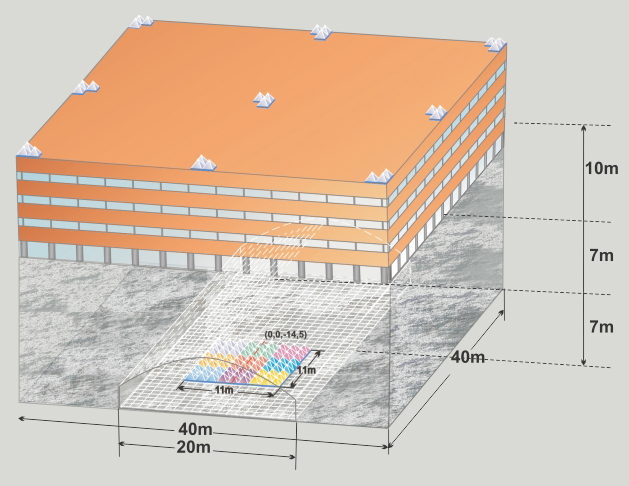АМММ

The Aragats Multichannel Muon Monitor (AMMM) consists from 2 layers of the scintillation detectors. 29 scintillation detectors (each detector have 1m2 surface and 5cm thickness), located on top of the top of ANI concrete calorimeter and 90 the same type detectors 14 m below (under 4m concrete and 7m soil), as shown in Figure 1 and Figure 2. Zenith angle between axes of AMMM and direction to South pole is ~-17º. Count rate in the upper detectors is ~28000 counts per minute and variance ~170. Count rate of each of 1m2 scintillators in the underground hall(high energy muons with energy threshold 5 GeV) is ~3000 counts per minute and variance ~55. The relative accuracy of 1-minute count rates of underground high energy muon detector is ~0.2%, of the low energy muons and electrons on surface ~ 0.12%.
DAQ electronics contain Micro PC. Data storing in the csv format on the Micro PC. Local Aragats ADAS File server download csv data from the Micro PC and convert them to the ADAS XML format. After transfer by wireless connections to CRD headquarters in Yerevan the data are archived and stored in MySQL data base. The main data analysis platform, Advanced Data Extraction Infrastructure (http://adei.info/) now is operated with data base and allow us download data in ASCII, CSV, ROOT formats (http://adei.crd.yerphi.am).
Raw data in the XML and csv formats is available from HTTP server at CRD headquarters in Yerevan from the linkhttp://192.168.24.118/index.php?page=data.php .
The first 30 columns are corresponding to the lower layer AMMM, the second 90 columns corresponding to the upper layer AMMM.
In Figure 3 we present the daily variations of the high energy secondary muons averaged over 21 days.
In Tables 1 and 2 we present averaged count rates as measured at 8 December 2007 and total number of muons measured by each detector per day. Total 248,292,843 muons were detected.
In Table 3 we present analogical characteristics for 29 plastic scintillators located on the top of ANI calorimeter.
New user-friendly interface to ASEC monitor data, named ADEI, is under final tuning and will highly improve physical analysis possibilities.
